Exist Yesterday: #Let5D0It, Week One
Hiya. It’s been a minute.
After nearly a half-decade of withdrawal from the music-writing conversations that I still think of as my primary online community, I’ve decided not only to participate in a social media poll but also to do a bunch of extra-credit work, in the hopes of jump-starting a return to habitually writing about music — and maybe other forms of art? Stay tuned.
What the following handful of newsletters are going to be, over the course of the next couple of months, are entries in #Let5D0It, a music poll organized by Arron Wright on Bluesky: 50 favorite singles from 1954 to 1976, posted as a once-per-day countdown. It’s a sequel to previous polls organized on Twitter, #Uncool50 (which covered post-1977 singles) and #FearofMu21C (which covered 2000-2023), and a prelude to a further two Bluesky polls, #UncoolTwo50 (re-covering 1977-1999 in line with subsequent polls) and #LetsDoIt25 (covering pre-1954 records). I was only tangentially aware of the previous polls, as I follow one or two people who participated but never checked in on Twitter frequently enough to keep up. But I’m engaging now because I have missed being casually immersed in music, that is, listening to all kinds of music for a wide variety of reasons instead of mainlining a very specific subcategory in order to spit out a year-end list or a Just One Song More update, both of which have fallen farther behind in recent years.
I’ll be posting one song a day on Bluesky, with a link to a blog post on my website where I develop my thoughts on each single, trying primarily to get at why I love it, although I’m afraid the habitual music-critic posture of “why it’s important” will inevitably creep in. Each post will end with a personal anecdote of where and why or how I first encountered the song, something that might not be possible for a lot of music nerds, but thanks to a notably radio-free childhood I encountered most of this music as an adult, and so have strong associations with most of it.
And because I don’t know how to do anything without doing too much, I am also compiling a further 50 lists (organized by genre) of 50 great singles released 1954-1976, which I will be posting toward the end of this countdown. This is purely for my own amusement and edification, as well as (selfishly) getting a bit of a head start on the research I have vaguely dreaded having to do for Just One Song More.
This email is a recap of the previous week's daily posts. You can follow along on Bluesky or my blog if you want the daily feed, or just wait for the weekly roundup via this newsletter. (New host, BTW, because fuck Substack.) I'm hoping I won't hit a wordcount limit.
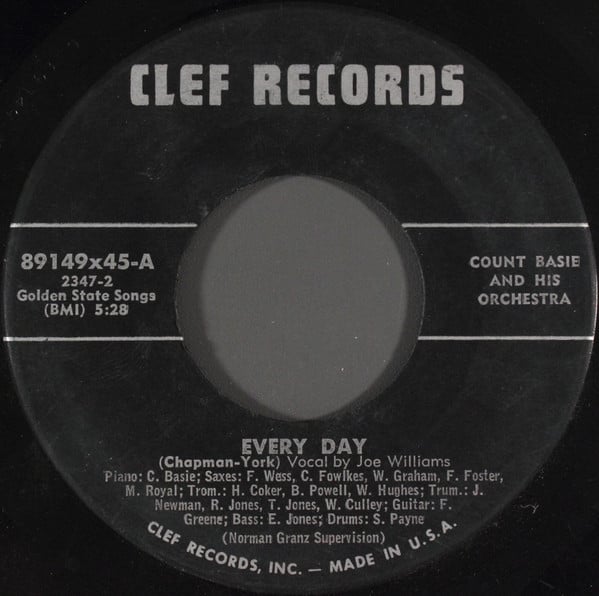
50. Count Basie & His Orchestra, Vocal by Joe Williams, “Every Day” (1955)
(Sparks/Sparks/Chatman/York) prod. Norman Granz
Clef 89149 | #2 R&B
“No-wo-wo-wo-wobody loves me, no-wo-wo-wo-wobody seems to care”
The purpose of this exercise, as I understand it, is to focus on the Rock Era, from the first (white) rock & roll records to the emergence of punk & disco. So why kick off with a massively ornate Swing Era orchestration of a plaintive 1930s blues song? Isn’t that crossing the streams? Surely stuff like this is Why Rock n’ Roll Had to Happen — it conjures visions of complacent suburbanites dropping a needle on the hi-fi, as opposed to hopped-up teenagers cramming into the malt shop to compete over control of the jukebox. All of which is entirely correct, until you actually listen to it. Nobody played louder than the Basie orchestra until oh, say, Led Zeppelin, and the authoritative, passionate manner in which Joe Williams attacks Memphis Slim’s sly electric revamp of Pinetop Sparks’ original blues is comparable, even preferable, to the elastic, shivery way that Robert Plant treated Zeppelin’s covers, credited or otherwise. (N.B. there is no Led Zeppelin on my list.) History doesn’t map neatly into Eras, with jazz being over once rock makes the scene: and in fact, by the mid-50s swing was more or less in the position that rock would be in circa the 70s: hardly out of juice, still pushing hard, sprawling into unconventional shapes, a music for adults communicating complexities of emotion rather than the hard-charging dance music with breaks for flashy solos that it had been in the 30s and 40s. The 1955 single miraculously preserves all 5:28 minutes of the song listed as “Every Day I Have the Blues” on the LP Count Basie Swings, Joe Williams Sings, and for once I don’t pine for a three-minute edit: just like the AOR gods of the early 70s, Basie, Williams and co. need every bit of that runtime to express their immense vision of heartbreak that also happens to blow the roof off the sucker.
First encounter: During an evening weekend drive accompanied by NPR, a jazz-hour DJ played Nnenna Freelon’s 2000 cover of Irene Kral’s 1963 “Better Than Anything”, a Cole Porter-style list song which namechecks, among a bunch of other contemporary references that the song’s love is better than, Bill Evans ballads and Joe Williams blues. I knew cool jazz pianist Bill Evans, but it took me an Allmusic.com search to learn that there was a Joe Williams aside from the Big Joe Williams who cut “Baby, Please Don’t Go” in 1935. (Rock-centric histories had prioritized my education in the Delta blues.) His records with Basie blew my mind: the immaculateness of his phrasing, the richness of his baritone, the rhythmic power of Basie’s band and the fluid density of Granz’s arrangements. At the time (2004-ish) I was doing a lot of walking around central Phoenix, imagining that I was gathering material for some kind of Bill Bryson-style observational travel book. The heat of the sun above ameliorated by the exquisite cool of the music in my headphones will stay with me a long, long time.
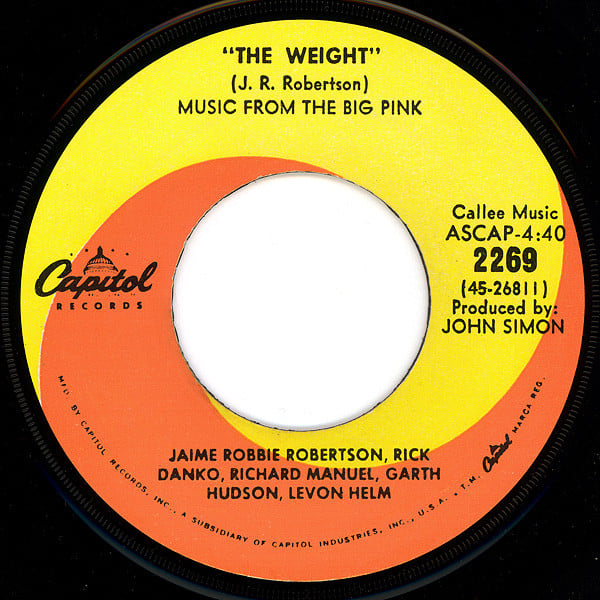
49. Jamie Robbie Robertson, Rick Danko, Richard Manuel, Garth Hudson, Levon Helm, “The Weight” (1968)
(Robertson) prod. John Simon
Capitol 2269 | #63 US, #21 UK
“It’s just old Luke and Luke’s waiting on the Judgment Day”
Now this is dead in the center of the Rock Era, having traveled far enough from the jump blues/country boogie roots of the music via twisting folk-rock pathways that it reads more like beatnik poetry gone to pasture than anything hormonal or amphetamined, and a keystone of the self-satisfied roots-rock parastructure that became part of what punk kicked against in the first place. Robertson’s (and, according to Helm, everyone else’s too) gnomic lyrics, recounting a vaguely surrealist narrative heavy on Biblical allusions and tangled moral obligations, crib heavily from Bob Dylan’s post-motorcycle crash strategy of drawing on the country, blues and gospel records compiled in Harry Smith’s Anthology of American Folk Music for inspiration. Fair enough, since Dylan’s recuperation at Rick Danko’s Big Pink was the occasion for the consolidation into a self-contained unit, rather than merely a backing group, of the outfit that would be credited on every subsequent release simply as The Band. But it’s not the song qua song, covered adeptly by dozens of equal or greater artists, but the record, that keeps pulling me back in: Manuel’s squalling organ functioning as a hi-fi version of an old 78 record’s surface noise against which Hudson’s piano sounds even more crisp, the alternately muddy and bright sound, in which voices and instruments emerge suddenly from a cavernous background like pedestrians in a fog — and like the images in the lyrics do, in fact. The three-part harmony, with Danko reaching just out of his range on those “and”s in the chorus, is the kind of imperfect, unpolished humanism that made me fall in love with this era in rock music in the first place. The vocal-coach approach to music criticism (shorthanded on social media as “having the range”) has its place, especially as a counter to smug rock orthodoxy, but I have a beguiled fondness for vocalists, especially from this era, who “can’t sing” but do anyway.
First encounter: Probably classic-rock radio. I spent quite a few years in the 2000s with the local classic rock station, the local oldies station, and NPR locked into my car stereo, with more occasional trips further up the dial to the alt-rock stations to remember my 90s roots. What opened it up to me, though, was reading Greil Marcus’s The Old, Weird America, a meditation on Dylan’s Basement Tapes with a lot of reference to Harry Smith’s Anthology — specifically I remember sitting mesmerized in the dark, grease-smelling file room of a car dealership/repair shop where I clerked ca. 2005, having just finished Greil’s book, while the beautifully jangly, quavery, surging, keening, stomping music of the Band spun from my Discman to my foam-padded headphones, wanting to crawl inside that echoey mix and stay there, singing along.
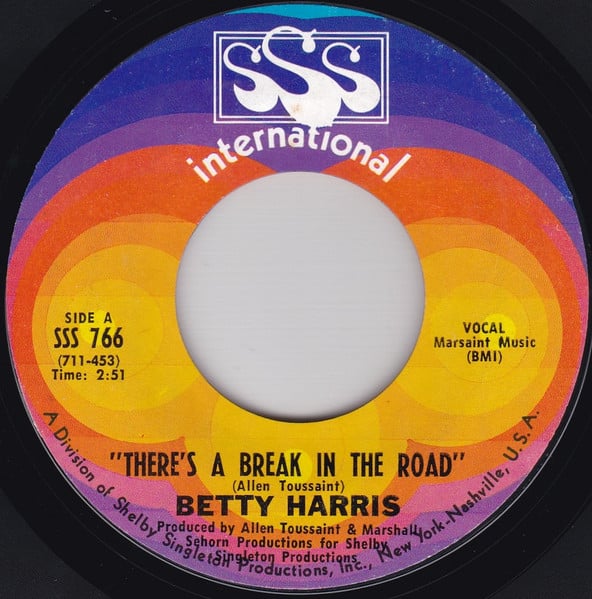
48. Betty Harris, “There’s a Break in the Road” (1969)
(Toussaint) prod. Allen Toussaint, Marshall Sehorn
SSS 766 | did not chart
“Same game you ran on me, somebody’s gonna run it on you”
There’s no Velvet Underground on this list either, even though my brain broke open shortly after I downloaded an mp3 of “Heroin” in 2000 because of a Rough Guide to Rock blurb. The discovery that music could be noise, and not in the troglodytic headbanging way that being a teenager in the early 90s had accustomed me to, but in a less testosteroney, more purely abstract way, was important to me; but more important was the discovery an embarrassing number of years later that funk >>>> droney churning. This song unites the best of both worlds, as a drummer who is either Zigaboo Modeliste or someone doing a great job imitating him lays down a stanky hard-funk rhythm while guitar feedback squalls irrepressibly from the speakers. Betty Harris’s forthright performance as a long-suffering woman who has had enough of being heartbroken by a faithless man, assuring him of karmic retribution, is exceptional, a highlight of an unjustly-neglected career as an also-ran Southern soul singer who never hit the big time despite being championed, as here, by some of the big names of New Orleans funk. It would take years of northern-soul cratedigging and reappraisal for this record to be widely available — its first legit reissue in the US wasn’t until a Sundazed comp in 2005. It’s not surprising that it didn’t chart, not so much because of the feedback (Hendrix at Monterey, Szabó on The Sorcerer, etc. meant it was in the air) but because the R&B charts of 1969 were overall far sweeter and mellower, with more pillowy orchestration, than this stripped-down, hard-stomping New Orleans funk.
First encounter: I must have picked up the UK reissue of most of her discography, Soul Perfection Plus, at some point in my record store visits in 2008 or 2009 and ripped it to mp3 along with a bunch of other new-to-me funk compilations, then loaded them into an iPod playlist for catching up on during a trip. I don’t remember now where I was going, but I do remember sitting in the aisle seat of an airplane waiting for takeoff, my eyes widening as the resonant shriek lacerated through the clipped snare patterns in my earbuds, and realizing that everything I thought I understood about the racial coding of electronic noise in rock music was wrong.
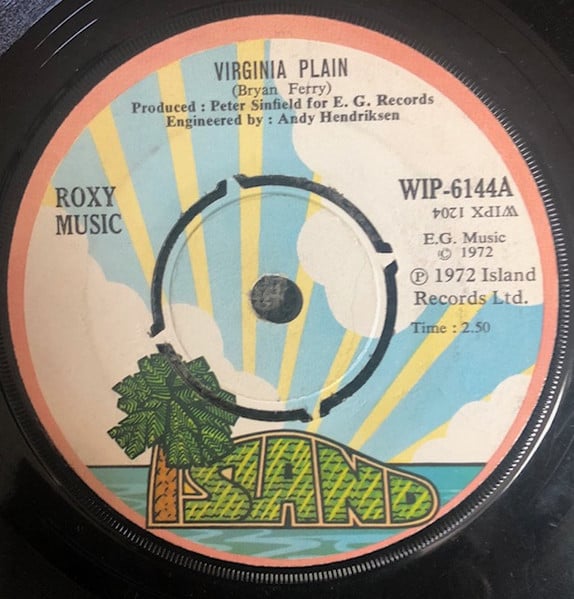
47. Roxy Music, “Virginia Plain” (1972)
(Ferry) prod. Peter Sinfield
Island WIP-6144 | UK #4
“Baby Jane’s in Acapulco, we are flying down to Riooooo”
My predominant association with Roxy Music is the sound of rushing air: velocity is one thing, and certainly present in “Virginia Plain,” but the airy textures of Andy Mackay’s woodwinds are, I think, the real secret engine, the sonic element that distances them from both the noodly boogie of the majority of British rock in the 70s and from the crunchy swing of the glam-rock felt as a fresh, youthful alternative (and where they got slotted in, more on a basis of image than sound). Of course plenty of rock overlaid with classical instrumentation was going on too; but there was nothing prog about Roxy. Paul Thompson’s drumming snapped as sharply and directly as Motown, Phil Manzanera’s processed guitars were more about texture than virtuosity, Mackay’s wind accents made a droll or impish counterpoint to Bryan Ferry’s arch, reference-laden lyrics, and of course Brian Eno applied synthesizers more like Jackson Pollock applying paint than like the dreary architectural pomposity of, say, Who’s Next. (Full disclosure: Who’s Next was my favorite album for a couple of years in the early 2000s.) Self-importance is one of the besetting 70s rock sins that Roxy Music rarely if ever indulged in: they could be obtuse, or louche, or toward the end simply dull, but the smirking wink with which Ferry delivered even his least attractive egocentricities kept them safely sheltered from any voice-of-their-generation wank. Which generation would that be, anyway? Because of all the Seventies rockers I learned to love in my twenties and thirties, none of them aside from Roxy Music seemed to feel the same way I did about jazz-age pop, that the swooning glamor of the Twenties and Thirties could be just as applicable to the (or, not to be too anachronistic, a) present as the blues grit and country twang that most of their contemporaries were chasing. Nothing about “Virginia Plain,” all hopped-up modernism, echoes the first Astaire–Rodgers film sonically, but Ferry makes the reference a lynchpin of the song: the dream of escape from the humdrum, whether via Hollywood trifle, jetsetting travel, or self-recreation as a form of art, is exactly what Roxy Music sold its listeners.
First encounter: That Rough Guide to Rock spurred me to download mp3s from For Your Pleasure, which I found mostly bewildering if ultimately seductive, but it wasn’t until 2003, when I conceived a foolhardy project to attempt to listen to all of the music from 1972 (spurred, implausibly enough, by a three-star album by folkie Josh Rouse) that I listened to “Virginia Plain” and found myself having to return to it again and again because it felt like pieces of it were missing: how could it cut off so suddenly like that? How could it have been a hit, even in the mysterious and incalculable UK? It felt more like a dense collage than a pop song; and it reminded me of how I had felt a few years earlier, going from listening to yarling post-grunge radio to Pet Sounds and Revolver and being appalled at how quickly every Beach Boys and Beatles song was over. Which meant, of course, that I had to have more of it.
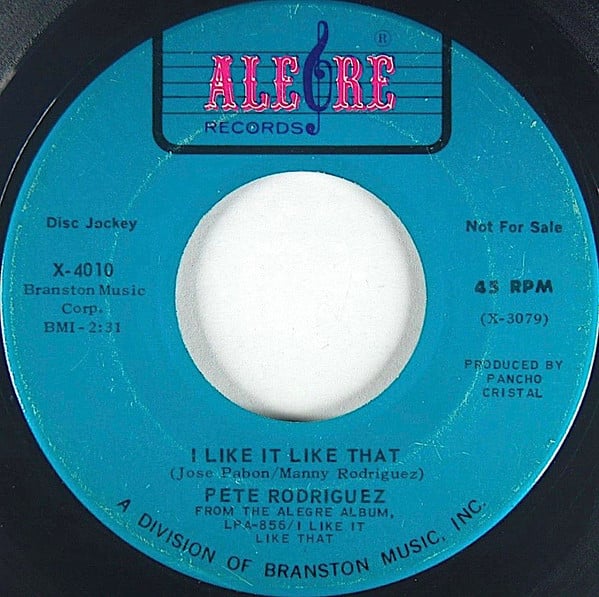
46. Pete Rodriguez, “I Like It Like That” (1967)
(Pabon/Rodriguez) prod. Pancho Cristal
Alegre 4010 | did not chart
“Stomp your feet if you think i’m neat, clap your hands if you want some more”
Perhaps my second-most persistent hobbyhorse over the last fifteen years of being involved in discussions about music online, after the granite-ribbed “pre-rock pop is just as valuable as rock-era pop,” has been the overwhelming, unjust, and ahistorical neglect of Latin music in standard Anglophone critical spaces. I give my UK coevals a grudging pass on this, since tejano, pachuco boogie, mambo, boogaloo, brown-eyed soul, salsa, freestyle, reggaeton, pop-bachata and more weren’t developed primarily within their borders and several Spanish-language radio formats aren’t a twist of the dial away in a market of any size; but US critics and editors who otherwise pride themselves on their wide listening (Yé-yé! Trópicalia! Dub reggae! Ethio-jazz! City pop!) and thorough grasp of US pop history (Girl groups! Countrypolitan! Soul-jazz! Bossa nova! Library music!) but somehow never seem to consider music in Spanish (or Spanglish) as cool, interesting, or significant as music in French, Portuguese, Japanese, and Patois make me want to bite something. Am I still grinding an axe about Pitchfork’s various 20th century lists, now more than a decade out of date? I appear to be, yes; and in all transparency I have to confess gratitude for their oversights, because it was the sense of outrage at having been offered an incomplete overview I felt when I started to learn more about the deep history of the genres listed above (plus many, many more around the world) that acted as the initial fuel for much of my subsequent engagement with and love for twentieth- and twenty-first-century Latin music. It still bothers me that, for example, a wide appreciation for disco has only rarely been tied by critics (pace Will Hermes) to the extensive history of Latin dance music in New York, of which this record (yes, I’m finally getting to it!) is a notable example. A relatively late entry in the boogaloo canon, it did not chart nationally, but it became a minor anthem within the five boroughs, fondly remembered enough that a 1993 movie set in the South Bronx could borrow the title and an all-star remake for the soundtrack could anchor an ad campaign for customizing hamburgers, spurring enough radio play and MTV rotation to get it to #25; not to mention its 2018 interpolation into a modern trap-reggaeton classic. The simple, repetitive structure, the titular refrain repeated over and over again (by neighborhood kids Pete invited to the recording session against the label boss’s wishes, goes the legend), lends itself to earworminess, with a descending montuno piano figure, handclaps, and congas as the rhythmic backbone. It’s a dance record as effective and party-ready as anything in the disco era, let alone the club banger era, and Pete Rodriguez’s hepcat spoken pronunciations over the beat even gesture toward rap to come.
First encounter: I grew up in a household that muted ads, but I have strong memories of hearing the Blackout Allstars remake over slow-motion glamor shots of Burger King ingredients anyway. But I wouldn’t start to get curious about boogaloo until I picked up a Fania sampler in the Virgin Megastore circa 2006, on which Eddie Palmieri’s deadpan-cool “Ay Que Rico” blew me away. I’m sure Pete Rodriguez got shuffled into a smattering of playlists after that, but it wasn’t until I compiled my own boogaloo mix in 2010 that I definitely paid attention to “I Like It Like That,” and the combination of 90s nostalgia with my then-current appreciation for scrappy 60s production sounds made it a no-brainer for inclusion.
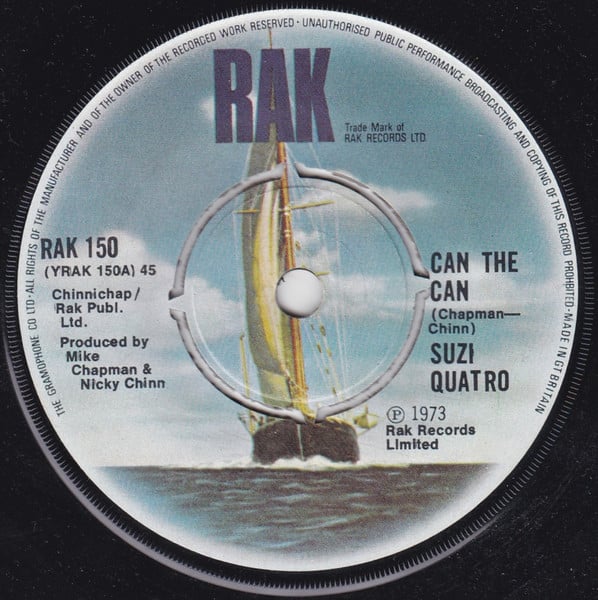
45. Suzi Quatro, “Can the Can” (1973)
(Chapman/Chinn) prod. Mike Chapman, Nicky Chinn
RAK 150 | #56 US, #1 UK
“But let the eagle take the tiger by surpriiiiiiise, SCRATCH OUT ER EYES”
An ongoing theme of these entries has been a squirming retrospective embarrassment at how much I have adored rock music over the years, so that I’ve swung from being half-apologetic about still liking a widely-beloved and respected single by the Band to eagerly assuring you that Roxy Music isn’t like the other 70s British rock bands, they’re cool and different. Some of that is probably an overcorrection: I spent a solid decade so focused on rock music (between 1995, when desperation to be socially legible in a Christian high school convinced me that musically, the only acceptable performance of masculinity was listening to rock, and 2005, about which more later) that it’s hard for me to hear past my youthful credulity and anxiousness to be understood as liking the correct things and into a sober valuation of the merits of a given piece of classic rock. But one thing I am relieved to learn I don’t fold into an automatic cringe over is loud, stomping rock sung by women. Maybe I’m just a Barbie (2023)-style libfem, but women getting rowdy and yelling with joyous swagger can still feel fresh and necessary when men doing the exact same thing often feels ugly and regressive. (But again, more later.) Suzi Quatro and “Can the Can” specifically function more like symbols than a coherent artist or artistic statement for me: the taught chugging-into-crescendos derived from T. Rex, who derived them from John Lee Hooker; the meaningless lyrics laden with just enough resonance to cross the threshold from the traditional girl group’s Song About a Boy to a rockstar’s Song of the Self; the Little Richard howls and whoops kicking off each chorus, each time more full-throated; even Chapman and Chinn’s plastic, airless production sound, sealing the single unalterably into a time capsule marked “1973” — all of it is satisfying in an abstract, weightless way that I’m more used to from 80s synthpop than from 70s hard rock, which I guess is just another way of saying that she feels ahead of her time.
First encounter: I have no memory of hearing it on classic rock radio, though I wouldn’t be surprised if I had; the first time I can remember actively paying attention to it was when I did a deep dive into glam and glitter for some message-board nerd cred in 2006 or so, partly inspired by Def Leppard’s covers album Yeah! but mostly attempting to show off how deep into Allmusic I could dive. Which by my current standards wasn’t very far: Suzi was the only female glam rocker I came up for air with, although I threw in Fanny’s cover of “Hey Bulldog” in a it-works-if-you-squint kind of way. Subsequent compilations, plus the expansion of my discographical horizons to sites like Rateyourmusic and Discogs, eventually showed me better; but “Can the Can” rocked me just hard enough that I can’t quit it.
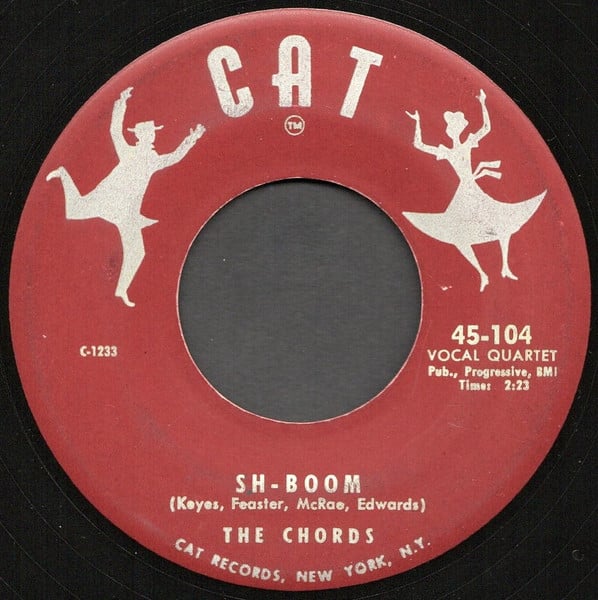
44. The Chords, “Sh-Boom” (1954)
(Keyes/Feaster/Feaster/McRae/Edwards)
Cat 104 | #2 R&B, #9 US
“Sha-lang-a-la-lang-a-la-lang-a-la-lang-a-la woah woah bip-ah-bo-da-do-da-dip whoah oh”
One of the great gifts that midcentury American music gave to the world is the nonsense vocables of doo wop, a genre itself only named in retrospect by imitating one of the most recurrent nonsense vocables, frequently deployed in imitation of a plucked bass (the doo) and horn section (the wop). Nonsense vocalizing that serves as a substitute for those too cash-poor to afford or attention-poor to learn instruments have been with humanity always, of course; but it was the American music business, with its tendency to amplify micro-trends by imitating the most easily replicable elements of the most recent hit record, thus reinforcing them enough that they can, over time, crystalize into genres, that applied industrial pressure to the street-corner harmonizing that was a near-ubiquitous pastime in postwar urban America. Hard, solitary practice went into trying to be a star jazz player; but harmony groups sold just as many records and were more fun because they were social. That this is the only doo wop record on my list is less a claim that it is the Best Doo Wop Record (as if such a thing could ever be determined) than an admission that many other genres are nearer to my heart. But if “Sh-Boom” doesn’t grab you I don’t know what will: the rapidity of its attack, the jazz harmonics on the “life could be a dream” refrain, Carl Feaster’s giddy nonsense vocables in lieu of an instrumental break, which I attempted to reproduce at the head of this blurb, the real instrumental break from Sam “the Man” Taylor on saxophone: it’s so much more vibrant and alive than nine-tenths of the music on 45 in 1954 (including the original flip, a Patti Page cover that was what the label wanted to sell, only reluctantly letting the Bronx teenagers calling themselves the Chords cut this, their own composition, on what was supposed to be the B side) that it still delivered an electric jolt when I ran across it on, of all places, TikTok earlier this year, soundtracking some absurdist clip or other. I have no idea what the kids these days think of it, other than just being something weird and alien from the past, but the fact that it’s alive enough to be made use of at all is telling.
First encounter: Like most of these records, there’s not much of an anecdote: I was devouring twentieth-century music by the bucketfuls in the early 2000s, and this came up during one of my periodic attempts to get my arms around the whole of a specific period. I liked it enough to include it in my list of 100 great rock & roll songs of the 1950s , but unlike a lot of those records it’s only grown in my estimation since.
Next week: #43-37, featuring a bunch of familiar names but one that may only be familiar to me.